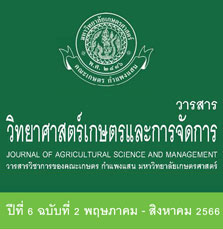การทดสอบประสิทธิภาพของเครื่องหมายโมเลกุลที่ใช้ในการคัดเลือกลักษณะทนร้อนในประชากรข้าวหอมที่พัฒนาขึ้นใหม่
คำสำคัญ:
ข้าว, ทนร้อน, ปรับปรุงพันธุ์, การติดเมล็ด, เครื่องหมายโมเลกุลบทคัดย่อ
การทดสอบประสิทธิภาพของเครื่องหมายโมเลกุลที่ใช้ในการคัดเลือกลักษณะทนร้อนได้รับการประเมินในประชากร BC2F3 จำนวน 13 สายพันธุ์ ที่ได้รับการปรับปรุงพันธุ์แบบผสมกลับโดยใช้ข้าวเจ้าหอม RGD13215-MS13-MS19-10-4-MS26 (RGD) เป็นสายพันธุ์รับและข้าวพันธุ์ Nagina-22 (N22) เป็นพันธุ์ให้ลักษณะทนร้อน การทดลองนี้ประเมินทั้งภายใต้สภาพโรงเรือนที่อุณหภูมิ 30-52 องศาเซลเซียส และสภาพแปลงที่อุณหภูมิ 22-37 องศาเซลเซียส ในระยะเจริญพันธุ์รวงจะได้รับการติดฉลากเมื่อใบธงอยู่ห่างจากใบถัดไประยะ 5 เซนติเมตร จำนวน 3 รวง/ต้น/ซ้ำ นับการติดเมล็ดในทุกรวงหลังการเก็บเกี่ยว โดยใช้ความสามารถในการติดเมล็ดเป็นดัชนีความทนร้อน พบว่า สายพันธุ์ที่มีอัลลีลแบบเดียวกับ N22 ในตำแหน่งเป้าหมาย จำนวน 7 สายพันธุ์ มีความสามารถติดเมล็ดสูงกว่าสายพันธุ์ที่มีอัลลีลแบบ RGD จำนวน 6 สายพันธุ์ อย่างมีนัยสำคัญทางสถิติ ทั้งในสภาพโรงเรือนและสภาพแปลง แสดงให้เห็นว่าเครื่องหมายโมเลกุลที่พัฒนาขึ้นมีประสิทธิภาพในการใช้คัดเลือกลักษณะการติดเมล็ดภายใต้อุณหภูมิสูงในฐานพันธุกรรมข้าว RGD เครื่องหมายโมเลกุลนี้จะได้รับการทดสอบประสิทธิภาพในประชากรอื่นๆ ที่มีฐานพันธุกรรมแตกต่างกันและในเชื้อพันธุกรรมอื่นๆ เพื่อให้เห็นศักยภาพในการนำไปใช้ในวงกว้างขึ้น
เอกสารอ้างอิง
Asian Development Bank. 2009. The economics of climate change in southeast Asia: a regional review. Manila: Asian Development Bank. 223 p.
Cao, L. Y., J.G. Zhao, , X.D. Zhan, D.L. Li, L.B. He and S.H. Cheng. 2003. Mapping QTLs for heat tolerance and correlation between heat tolerance and photosynthetic rate in rice. Chinese Journal of Rice Science 17(3): 223-227.
Catherine, C., N.D. Gemma and Victoria te Velde of Agulhas. 2012. Managing climate extremes and disasters in Asia: lessons from the IPCC SREX reports. Climate and Development Knowledge Network. pp 12-15.
Chen, Q.Q., S.B. Yu, C.H. Li and T.M. Mou. 2008. Identification of QTLs for heat tolerance at flowering stage in rice. Scientia Agricultura Sinica 41: 315–321.
FAOSTAT. 2017. Crops and Livestock Products. (Online). Available Source: https://www.fao.org/faostat/. (January 20, 2022).
IPCC (Intergovernmental Panel on Climate Change). 2007. Climate Change 2007: The Physical Science Basis. Contribution of Working Group I to the Fourth Assessment Report of the Intergovernmental Panel on Climate Change. S. Solomon, D. Qin, M. Manning, Z. Chen, M. Marquis, K.B. Averyt, M. Tignor, and H.L. Miller, eds. Cambridge University Press, Cambridge, United Kingdom and New York, NY, USA. 996 p.
IPCC. 2012. Summary for policy makers. In: Field, C.B., V. Barros, T.F. Stocker, D. Qin, D.J. Dokken, K.L. Ebi, M.D. Mastrandrea, K.J. Mach, G.K. Plattner, S.K. Allen, M. Tignor, P.M. Midgley. Managing the Risks of Extreme Events and Disasters to Advance Climate Change Adaptation A Special Report of Working Groups I and II of the Inter-Governmental Panel on Climate Change. Cambridge University Press, Cambridge, United Kingdom and New York, NY, USA, pp 1-19.
Jagadish, S.V., P.Q. Craufurd and T.R. Wheeler. 2007. High temperature stress and spikelet fertility in rice (Oryza sativa L.). Journal of Experimental Botany 58: 1627-1635.
Jagadish, S.V.K., R. Mathurajan, R. Oane, T.R. Wheeler, S. Heuer, J. Bennett and P.Q. Carufurd. 2010. Physiological and proteomic approaches to address to address heat tolerance during anthesis in rice (Oryza sativa L.). Journal of Experimental Botany 61: 143-156.
Kui, L.M., L.B. Tan, J. Tu, Y.X. Lu and C.Q. Sun. 2008. Identification of QTLs associated with heat tolerance of Yuanjiang common wild rice (Oryza rufipogon Griff.) at flowering stage. Journal of Agricultural Biotechnology 16: 461–464.
Lafarge, T., C. Bueno, J. Frouin, L. Jacquin, B. Courtois and N. Ahmadi. 2017. Genome-wide association analysis for heat tolerance at flowering detected a large set of genes involved in adaptation to thermal and other stresses. PLOS ONE 12(2): e0171254. doi:10.1371/journal.pone.0171254.
Osada, A., V. Sasiprada, M. Rahong, S. Dhammanuvong and M. Chakrabandhu. 1973. Abnormal occurrence of empty grains of indica rice plants in the dry, hot season in Thailand. Proceedings of the Crop Science Society of Japan 42(1): 103-109.
Prasad, P.V.V., K.J. Boote, L. Allen, J. Sheehy and J.M.G. Thomas. 2006. Species, ecotype and cultivar differences in spikelet fertility and harvest index of rice in response to high temperature stress. Field Crops Research 95: 398-411.
Satake, T. and S. Yoshida. 1978. High temperature induced sterility in indica rices at flowering. Japanese Journal of Crop Science 47: 6-17.
Xiao, Y.H., Y. Pan, L.H. Luo, H.B. Deng, G.I. Zhang, W.B. Tang and L.Y. Chen. 2011. Quantitative trait loci associated with seed set under high temperature stress at the flowering stage in rice (Oryza sativa L.). Euphytica 178: 331-338.
Ye, C., M. Argayoso, E. Redoña, S. Sierra, M. Laza, C. Dilla and J. Hernandez. 2012. Mapping QTL for heat tolerance at flowering stage in rice using SNP markers. Plant Breeding 131: 33–41.
Ye, C., F. Tenorio, E. Redoña, P. Morales-Cortezano, G. Cabrega, K.V. Jagadish and G. Gregorio. 2015. Fine-mapping and validating qHTSF4.1 to increase spikelet fertility under heat stress at flowering in rice. Theoretical and Applied Genetics 128: 1507–1517.
Zhang, T., L. Yang, K.F. Jang, M. Huang, Q. Sun, W.F. Chen and J.K. Zheng. 2008. QTL mapping for heat tolerance of the tassel period of rice. Molecular Plant Breeding 6: 867-873.
Zhao, Z.G., L. Jiang, Y.H. Xiao, W.W. Zhang, H.Q. Zhai and J.M. Wan. 2006. Identification of QTLs for heat tolerance at the booting stage in rice (Oryza sativa L.). Acta Agronomica Sinica 32: 640–644.






